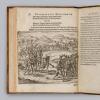Thomas Hariot, A briefe and true report of the new found land of Virginia (Amsterdam, 1590)
Commentary
In June 1585, Sir Richard Grenville left 100 colonisers under the command of Ralph Lane on Roanoke Island, just off the coast of North Carolina. One of the men was Thomas Hariot (1560-1621), author of A briefe and true report. Though their attempt at establishing a settlement would end in failure, the voyage enabled Hariot to compile the first comprehensive report about America for an English audience. His report would eventually take the form of this book which, upon their return from the colony, was published in 1588. The edition on display here, published in 1590, is accompanied by engravings by Theodor de Bry, which are based on the original illustrations from John White, the expedition’s cartographer.
Hariot’s report on the failed colony at Roanoke was beneficial for future colonies like Jamestown. Though he had freely admitted the fact that America was not rich in gold, Hariot went to great lengths to emphasise the vast quantity of commercially lucrative plants and the edible animals, conducting a thorough recording of as many living things as he could find. His efforts helped paint America as a land of wealth and opportunity, and this no doubt attracted other potential settlers whilst also serving as a counter to the reports that America was not as prosperous as was first thought. Hariot’s account of the native Americans is still viewed as one of the most detailed and impartial.
(British Museum, 1906,0509.1.16) © The Trustees of the British Museum
The image above, whilst labelled ‘The Flyer’ in White’s original watercolour (made between 1585-93), is labelled as ‘The Conjuror’ by the book’s engraver Theodor de Bry. It depicts a native who would have been well versed in his people’s medical practices, portraying him midway through a ritualistic ‘dance’. Hariot described these men as ‘familiar with devils’, consulting them in order to foresee the future and learn of their enemies’ movements. The man shown here wears a headdress decorated with a bird, and a tobacco pouch on his belt. This, as Harriot described, was taken in extreme doses so as to induce an ecstatic trance-like state that the natives believed was beloved by their Gods.
Sources
Kim Sloan, A New World: England's First View of America (London, 2007), no. 17, pp. 128-29

